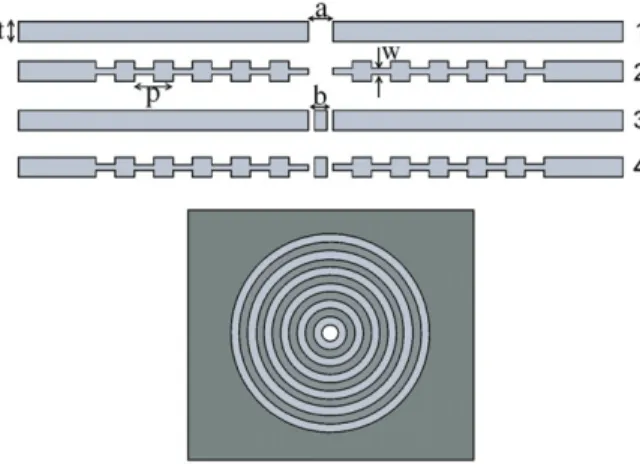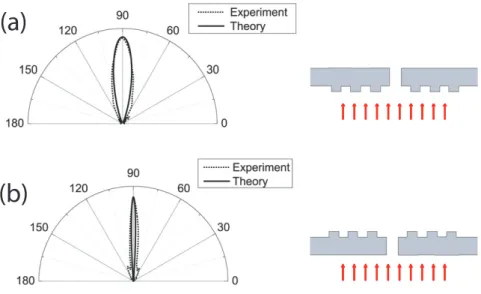Journal of Physics: Conference Series
Plasmonic structures with highly directional
beaming properties
To cite this article: Humeyra Caglayan et al 2006 J. Phys.: Conf. Ser. 36 41
View the article online for updates and enhancements.
Related content
Terahertz Wave Enhanced Transmission through a Single Subwavelength Aperture with Periodic Surface Structures
Kunihiko Ishihara, Gen-ichi Hatakoshi, Tomofumi Ikari et al.
-Scattering and Diffraction of Electromagnetic Wave by 3D Periodic Structures with Subwavelength Scales:Self-consistent Field Approach* Li Zhiyuan, Gu Benyuan and Yang Guozhen
-Highly Directional Emission from a Subwavelength Slit inMetal-Dielectric Layered Films
Li Zu-Bin, Tian Jian-Guo, Zhou Wen-Yuan et al.
Plasmonic structures with highly directional beaming
properties
Humeyra Caglayan, Irfan Bulu, and Ekmel Ozbay
Department of Physics and the Nanotechnology Research Center, Bilkent University, 06800 Ankara, Turkey
E-mail: caglayan@fen.bilkent.edu.tr
Abstract. We studied the diffraction of electromagnetic waves from subwavelength metallic
circular apertures in the microwave spectrum. The metallic samples had a subwavelength hole with a diameter of 8 mm and had concentric grooves with a periodicity of 16 mm. We present the angular transmission distributions from circular annular apertures, and circular annular apertures surrounded by concentric periodic grooves. At the surface mode resonance frequency the transmitted electromagnetic waves from the subwavelength circular annular aperture surrounded by concentric periodic grooves have a strong angular confinement with an angular divergence of ±3o. This represents a fourfold reduction when compared to the angular divergence of the beam transmitted from the subwavelength circular aperture.
1. Introduction
The transmission of electromagnetic (EM) waves through a single subwavelength aperture has been studied for many years. As defined in the standard diffraction theory by Bethe [1] in 1944, a circular aperture with a subwavelength diameter transmits EM waves rather poorly ∼ (d/λ)4 and exiting EM waves are fully diffracted in all directions. These two disadvantages
of low transmission and diffraction are the main problems of manipulating light, especially at the subwavelength scales. However, it has been shown that not only the enhancement of the transmission but also the confinement of the transmitted beam is possible by surrounding the metal surface of the subwavelength apertures with periodic corrugations [2].
Surface plasmons (SPs) are collective excitation of the electrons at the surface of a conductor. As SP modes have longer wave vectors than light waves of the same energy, electromagnetic radiation does not interact with the SP modes of a smooth metal surface [3]. The use of SPs helps us to concentrate light in subwavelength structures that is obtained with different permittivities of the metal and the surrounding media. Beaming of light through a single aperture with periodic surface corrugations around the aperture were shown experimentally and studied theoretically [2, 4, 5]. It was also shown theoretically that it is possible to optimize the angular confinement using a subwavelength circular coaxial aperture with a surrounding array of grooves [6].
We have reported enhanced transmission through subwavelength circular coaxial apertures in the microwave regime. This enhanced transmission is assisted by the guided mode of the coaxial waveguide and coupling to the surface plasmons [7]. In this paper, we investigated the highly directional beaming properties of the EM waves emitted from sub-wavelength circular annular apertures and circular annular apertures surrounded by concentric periodic grooves.
41 © 2006 IOP Publishing Ltd
2. Experiment and results
We used four metallic (aluminum) structures in this work. All the structures have a subwavelength hole in the center with a diameter of (a) 8 mm. The gratingless sample (Sample 1) with a thickness of (t) 8 mm was used as a reference sample. The second sample has an identical aperture surrounded by six rectangular grooves. The periodicity of the grooves is 16 mm and the thickness of the grooved metal (w) is 3.2 mm. The schematic description of our structures is shown in Fig. 1. The measurements were performed in the microwave spectrum of 10-18 GHz, corresponding to a wavelength region of 16.7-30 mm. The experimental setup consists of an HP 8510C network analyzer and two standard gain horn antennas to measure the transmission amplitude. Radiation is normally incident upon the sample from 15 cm by the source antenna. In the experimental setup for angular distribution measurements the receiver antenna is placed 50 cm (22λ) away from the sample’s back side and was connected to a rotating arm to measure the angular dependence of the field radiation (Fig 2). We change the angle of the receiver antenna with the help of rotating arm. We have 10 resolution in this experimental setup.
Figure 1. Schematics of the four metallic samples and top view of Sample 2.
Transmission spectrum of these structures were presented in our previous paper [7]. For Sample 2, a transmission peak was observed around 13 GHz with a transmission amplitude of 0.025. A twentyfold enhancement was achieved around the SP resonance frequency with Sample 2 with respect to our reference sample (Sample 1). For a further increase in transmission, we designed an coaxial waveguide with a TE mode around 13 GHz. This structure (Sample 3) is identical to Sample 1 with a rod inside the hole. The diameter of the rod is 6.6 mm and the length of the rod is 8 mm. The combination of the coaxial waveguide (annular aperture) and grooved structure (Sample 4) showed extraordinary high transmission at 12.9 GHz (23.25 mm). Compared to Sample 2, there is a 7.5 fold increment in enhancement factor. Also, note that the area of the hole in Sample 1 is 16π2 and in Sample 4 this hole area is reduced by a factor of 3.13 with respect to Sample 1. If we include the reduction in the area of the aperture, a 450-fold enhancement is obtained through the subwavelength annular aperture. The combination of SP resonance and TE mode resonance at the same frequency enable us to achieve such a high transmission.
We measured the angular distributions for our four samples. Figure 3 shows the normalized measured and calculated angular transmission distribution at the resonance frequency for Sample 1 and 2. The angular divergence of the beam transmitted through Sample 1 is ±12o, whereas the that of the beam that emerges from Sample 2 is ±3o. Although, in both sample 42
Figure 2. The experimental setup used in angular distribution measurements. 0 30 60 90 120 150 180 Sample 1 Sample 2
Figure 3. Normalized angular transmission distribution for a) Sample 1 and b) Sample 2 at
the resonance frequency (13 GHz).
electromagnetic waves transmitted from a subwavelength aperture, the angular divergence of the beam transmitted through Sample 2 reduced four-fold compared to the that of Sample 1.
The angular transmission intensity distribution at the enhanced transmission frequency (13 GHz) for Samples 3 and 4 is presented in Fig. 4. FWHM divergence of the beam is ±12o and ±3o for Samples 3 and 4, respectively. The angular divergence of the beam transmitted through
Sample 3 is very similar to the beam transmitted through Sample 1. Moreover, the angular divergence of the beam transmitted through Sample 2 is very similar to the beam transmitted through Sample 4. Hence, there is an angular confinement for the beams transmitted from grooved samples; the confinement can be attributed to the grooves on the surface of samples.
Last, we investigate which surface is responsible for the beaming effect and design a circular aperture with grooves on only one of sides of the metal block. The angular distributions of EM
0 30 60 90 120 150 180 Sample 3 Sample 4
Figure 4. Normalized angular transmission distribution for a) Sample 3 and b) Sample 4 at
the resonance frequency (13 GHz).
Figure 5. Normalized angular transmission distribution for one-sided grooved samples at the
resonance frequency.
waves transmitted through different sides are shown in Fig. 5. These results show that when we illuminate the sample on the side of a grooved surface (no grooves on the exit surface), we could not observe a beaming effect. On the other hand, when the sample is illuminated on the side of the flat surface such that the output surface is grooved, a beaming effect occurs. This can be interpreted as only the output surface being responsible for the beaming effect.
3. Conclusion
In conclusion, we presented the angular distributions of EM waves transmitted from sub-wavelength circular annular apertures with and without concentric periodic grooves in the microwave regime. We showed that the beam transmitted from circular apertures surrounded by concentric periodic grooves has an angular divergence of ±3o. Hence, the beam is fourfold reduced compared to the beam transmitted through a subwavelength aperture (Sample 1) at the SP resonance frequency. Furthermore, we presented we measured the normalized angular transmission distributions from one sided samples and we observed that only the output surface 44
being responsible for the beaming effect.
References
[1] Bethe H A 1944 Phys. Rev.66 163
[2] Lezec H J, Degiron A, Devaux E, Linke R A, Martin-Moreno L, Garcia-Vidal F J and Ebbesen T W 2002 Science297 820
[3] Raether H 1988 Surface Plasmons on Smooth and Rough Surfaces and on Gratings (Springer-Verlag, Berlin )
[4] Akarca-Biyikli S S, Bulu I and Ozbay E 2004 Appl. Phys. Lett.85 1098
[5] Lockyear M J, Hibbins A P, Sambles J R and Lawrence C R 2004 Appl. Phys. Lett.84 2040 [6] Baida F I, Van Labeke D and Guzial B 2003 Appl. Opt.42 6811


